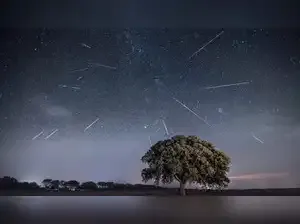On the night of 29–30 July, skies across the world will come alive with a rare and striking natural show. Two meteor showers — the Southern Delta Aquariids and the Alpha Capricornids — will peak at the same time. What makes this especially exciting is the absence of moonlight, which means dark, clear skies and uninterrupted views of up to 25 meteors an hour.
Astronomers say this is one of the most promising viewing windows in years.
“With the Moon out of the way, dark skies will offer a chance to see up to 25 shooting stars per hour, making it a perfect time for stargazing,” experts noted.
While both showers will be visible worldwide, the Southern Hemisphere offers the best conditions. That’s because the constellations Aquarius and Capricornus, from which these meteors appear to originate, rise higher in southern skies.
These meteors come from Comet 96P/Machholz, a small, short-period comet that has left a consistent debris trail along Earth’s orbital path.
The broad peak of this shower gives observers more than just one night. Meteor activity is expected to remain strong through to 31 July. So even if cloud cover spoils the main night, there are still good chances to catch the event.
“The Southern Delta Aquariids have a broad peak, meaning good meteor rates can be seen for about a week until July 31,” according to astronomers.
For Northern Hemisphere viewers, Aquarius sits lower on the southern horizon, so early morning hours before sunrise are best for spotting the meteors. In the south, the constellation rises higher and earlier, making the show easier to catch.
“They often appear as slow, bright fireballs in colour,” experts said.
The Alpha Capricornids originate from Comet 169P/NEAT, a 3-kilometre-wide body that was only discovered in 2002. It completes its orbit around the Sun every 4.2 years. Earth’s passage through its trail gives rise to these brilliant meteors.
Because Capricornus lies close to Aquarius in the sky, it’s hard to tell which meteor belongs to which shower. But most people watching from Earth won't mind — the combined effect is what counts.
Rural areas will offer the darkest skies. Avoid streetlights and let your eyes adjust for at least 20 to 30 minutes. No telescope needed — just look south and be patient. Meteors often come in bursts.
The pre-dawn hours of 30 July are likely to offer the best show, especially for those in the Southern Hemisphere.
“The Southern Hemisphere offers the best viewing conditions, as both constellations are higher in the sky,” astronomers have confirmed.
While these two showers are annual events, they rarely reach their peak together with such clear skies. This year’s lack of moonlight makes the timing near perfect.
Astronomers say this is one of the most promising viewing windows in years.
“With the Moon out of the way, dark skies will offer a chance to see up to 25 shooting stars per hour, making it a perfect time for stargazing,” experts noted.
While both showers will be visible worldwide, the Southern Hemisphere offers the best conditions. That’s because the constellations Aquarius and Capricornus, from which these meteors appear to originate, rise higher in southern skies.
Meet the showstopper: Southern Delta Aquariids
The Southern Delta Aquariids are the main draw. Active from 18 July to 12 August, they are known for their subtle, fast-moving streaks that often leave long-lasting trails. At their peak, they’re expected to produce around 20 meteors per hour.These meteors come from Comet 96P/Machholz, a small, short-period comet that has left a consistent debris trail along Earth’s orbital path.
The broad peak of this shower gives observers more than just one night. Meteor activity is expected to remain strong through to 31 July. So even if cloud cover spoils the main night, there are still good chances to catch the event.
“The Southern Delta Aquariids have a broad peak, meaning good meteor rates can be seen for about a week until July 31,” according to astronomers.
For Northern Hemisphere viewers, Aquarius sits lower on the southern horizon, so early morning hours before sunrise are best for spotting the meteors. In the south, the constellation rises higher and earlier, making the show easier to catch.
Fireballs from the Alpha Capricornids
While smaller in number, the Alpha Capricornids bring their own visual drama. Active from 7 July to 15 August, this shower adds five to ten meteors per hour. What they lack in quantity, they make up for in quality. These meteors are slow, often bright, and sometimes colourful.“They often appear as slow, bright fireballs in colour,” experts said.
The Alpha Capricornids originate from Comet 169P/NEAT, a 3-kilometre-wide body that was only discovered in 2002. It completes its orbit around the Sun every 4.2 years. Earth’s passage through its trail gives rise to these brilliant meteors.
Because Capricornus lies close to Aquarius in the sky, it’s hard to tell which meteor belongs to which shower. But most people watching from Earth won't mind — the combined effect is what counts.
Best time and place to watch
Where you are will influence how much you see, but the advice is broadly the same.Rural areas will offer the darkest skies. Avoid streetlights and let your eyes adjust for at least 20 to 30 minutes. No telescope needed — just look south and be patient. Meteors often come in bursts.
The pre-dawn hours of 30 July are likely to offer the best show, especially for those in the Southern Hemisphere.
“The Southern Hemisphere offers the best viewing conditions, as both constellations are higher in the sky,” astronomers have confirmed.
What causes meteor showers
Meteor showers like these happen when Earth passes through streams of debris left behind by comets. As bits of rock and ice burn up in the atmosphere, they produce streaks of light — what we call shooting stars.While these two showers are annual events, they rarely reach their peak together with such clear skies. This year’s lack of moonlight makes the timing near perfect.
How to prepare for the event
If you're planning to watch, consider the following tips:- Get away from city lights and find an open space with a wide view of the sky
- Lie flat or use a reclining chair to reduce neck strain
- Let your eyes adjust to the dark for at least 20 minutes
- Bring warm clothes and something to eat or drink
- Look generally south and give it time — patience pays off








